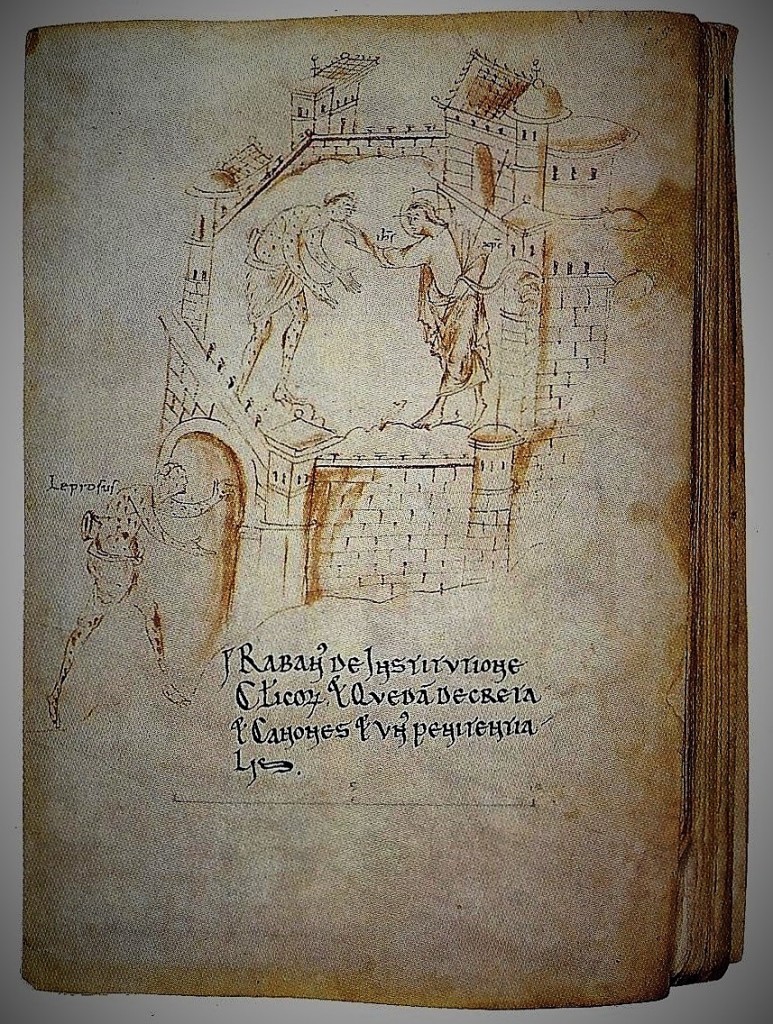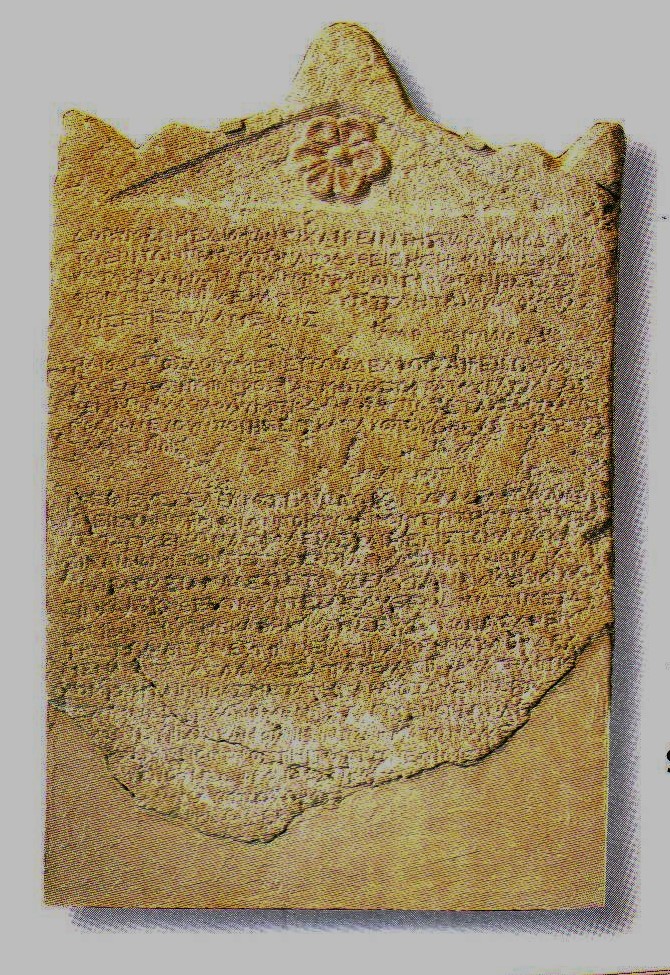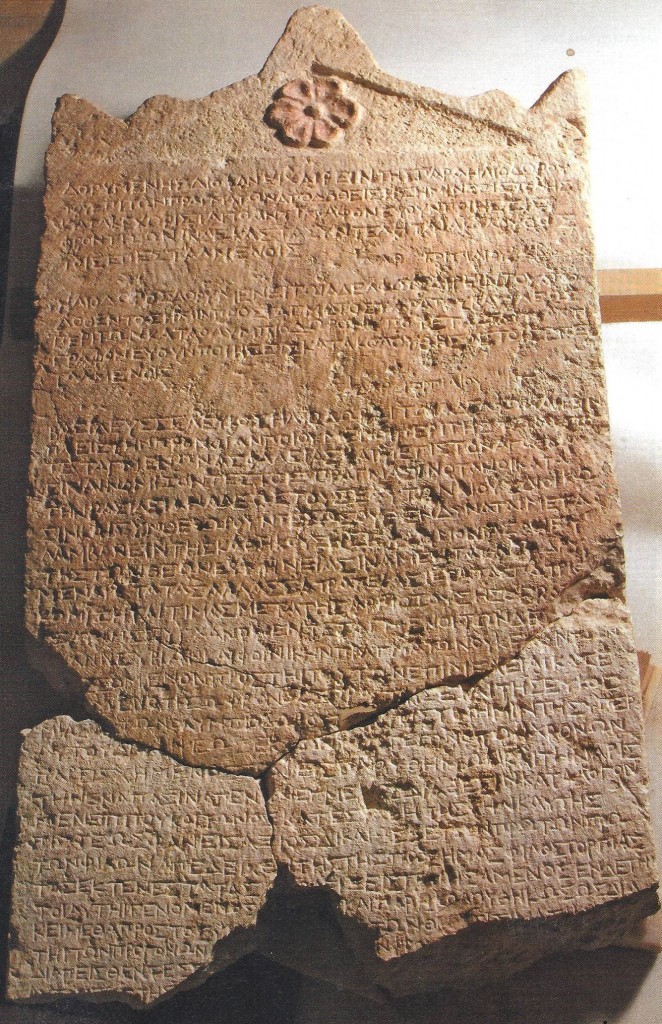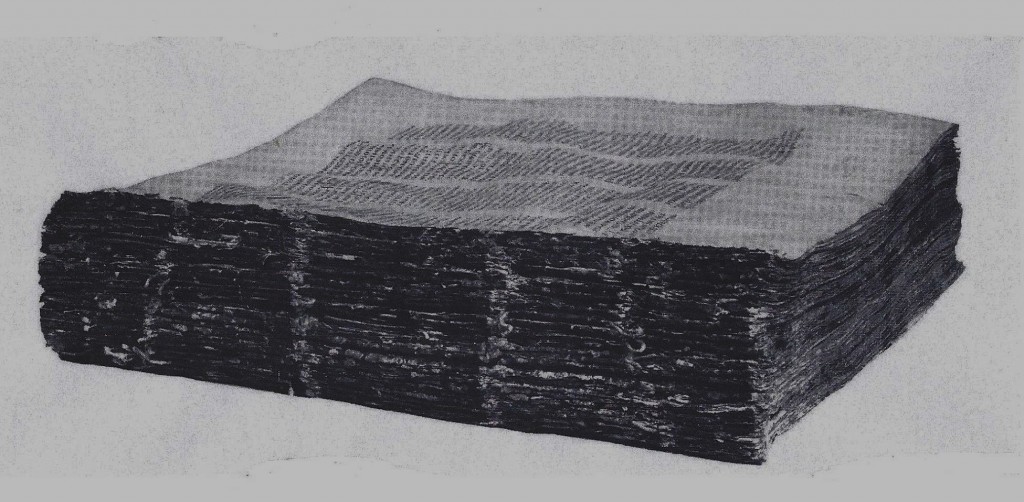Unit 02
Cultural Background Studies
Chapter 02
Biblical And Extra-Biblical Writings

02.02.00.A. JESUS HEALS THE LEPER. Artist unknown. A ninth century Pen-and-ink drawing depicts a leper with spots coming to Jesus for a healing. Vatican Files.
Unit 02
Cultural Background Studies
Chapter 02
Biblical And Extra-Biblical Writings

02.02.00.A. JESUS HEALS THE LEPER. Artist unknown. A ninth century Pen-and-ink drawing depicts a leper with spots coming to Jesus for a healing. Vatican Files.
02.02.01 Introduction. This study contains dozens of quotations from ancient extra-biblical sources. The importance of these writings lies in the fact that they aid in the understanding of the problems of daily first century life, including theological discussions, major cultural, historical events, and the reaction of rulers and people to various problems. A brief description of each source is given so the reader will understand why some extra-biblical writings are more reliable and significant than others. For example, books such as the Didache (a first century church document) and Mishnah (the written version of the Oral Law) are important while other works, such as the Gnostic writings, hold almost no historical value and are theologically worthless and possibly deceptive.
As stated previously, for the purpose of this study, the ideal writer of yesteryear quoted herein was one who lived in the land of Jesus and at the time of Jesus. The further in time and geographical distance an ancient writer was from the life of Christ, the more suspect his manuscript becomes. That does not negate it – but it raises the bar for discerning critique. Scholars universally discount writings after the sixth or seventh centuries. There are hundreds of old manuscripts in the possession of universities and museums pretending to provide additional detail to the life and ministry of Jesus, and nearly all of them are fanciful stories that should never have been written.[1]
Video Insert >
02.02.01.V The Significance of Inter-Testamental Writings. Dr. Douglas Finkbeiner summarizes seven important classifications of Inter-Testamental writings and their contributions to understanding first century Jewish life. (45:37)
[1]. Two examples are: 1) Ron Charles, who has gathered scores of fanciful legends and myths, mostly written between the sixth and sixteenth centuries, that pertain to the life of Christ in his book titled, The Search: A Historian’s Search for Historical Jesus. (Self-Published, 2007). 2) Nicholas Notovich, whose book, The Unknown Life of Jesus Christ. Trans. (Virchand R. Gandhi, Dover Pub.) is a so-called historical account of when Jesus went to Asia to study between the ages 13 and 29.
02.02.02 Ante-Nicene Fathers. The Ante-Nicene Fathers are those church leaders who were influential prior to the Church Council of Nicea in the year 325, but after the Apostolic Fathers who were personally taught by the apostles. The ante-Nicene Fathers discussed a wide variety of theological and church issues. Since they lived within three centuries of Jesus, they present valuable insight into the cultural and background setting, as well as early interpretations of Scripture.
02.02.03 Apocrypha. The Apocrypha[1] is a collection of about fourteen books[2] written, for the most part, during the Inter-Testamental Period in the Holy Land.[3] However, It was the intent of the authors to write a message to an inner circle of the faithful, which could not be understood by outsiders. Hence the Greek name apokryphos, meaning “hidden” or “concealed.”[4] The Roman Catholic[5] and Eastern Orthodox Churches have accepted them as inspired Scriptures.[6] Protestants, however, recognized these books only for the historical values, as they believe these add nothing of theological value to the canonical Scripture.[7] They enhance the understanding of the Greco-Roman-Jewish atmosphere and are a witness to the faith of the Jewish people living in the second century B.C. Hence, these provide essential historical background for understanding the Judaism of Jesus’ day and the Jewish matrix of early Christianity.[8] Each book must be evaluated for its worth and intended use in a particular study. For example, the book of Judith is essentially a book of fables common in the days of Jesus, whereas 1 and 2 Maccabees are both well-written, highly respected contemporaneous historical accounts of the second century B.C.
Apocalyptic literature appears in both the Apocrypha and Pseudepigrapha. The very nature of the word “apocalyptic” has the meaning of pending divine judgment and an end of the world.[9] These authors were convinced of the following:
Two biblical books that are outstanding examples of apocalyptic literature are Daniel and the Revelation.[11] Like the Pseudepigrapha (described below), some Apocrypha books were written in part to justify portions of Scripture that were embarrassing to the Jews. Since they had elevated their patriarchs to near deity level, they could not accept the fact that they were men who had sinned and were extended forgiveness by the grace of God. This is evidence of the theological chaos that existed in the first centuries B.C. and A.D. Jerome made this comment about these books in his Letter to Laeta.
They are not written by those to whom they were ascribed … many faulty elements have been introduced into them, and … it requires infinite discretion to look for gold in the midst of dirt.
Jerome, Letter to Laeta
A number of older Bible manuscripts, such as the Sinaitic, Vatican, and Alexandrian contain the Apocrypha. The oldest Syriac version does not have it but newer ones do.[12] It was first printed in the English language in 1535 as part of the Coverdale Bible where it was placed between the Old and New Testaments. It was often a part of the Protestant Bible, but solely for its historical value until 1827.[13] By the end of the 1800s, all Protestant Bibles eliminated the Apocrypha while the Roman Catholic and Eastern Orthodox Bibles continue to include it.
Two of the books within the Apocrypha category are 1 and 2 Maccabees. Some scholars have questioned the reliability of these works, until the Heliodorus Stele was discovered. The inscribed stone preserves part of a letter of King Seleucus IV Philopator (218-175 B.C.) that was written to a Seleucid official, Heliodorus, who is believed to have been the assassin of the king. The account provides the historical context for the royal official Heliodorus named in the miraculous story in 2 Maccabees, chapter 3. The communication was engraved in the stone stele for public display. In it the king discusses the proper care of temples in his domain, specifically Coele-Syria and Phoenicia, which included Judaea.[14] The king’s proclamation represents the beginning of royal policy of religious exploitation and interference that would lead to the Maccabean Revolt a decade later.


02.02.03.A. THE HELIODORUS STELE. LEFT: This stele, dated to 178 B.C., is shown with the missing portions in place, and RIGHT: the portions discovered in 2005 and 2006. It illustrates the background of 2 Maccabees and demonstrates that the book is an authentic and independent information source on this historical period. The inscription marks the beginning of the Greek-Seleucid intervention of Jewish life that eventually led to the Maccabean Revolt in 167 B.C. Heliodorus was ordered by King Seleucus IV (reigned 189-175 B.C.) to remove the treasures from the Jewish temple. The king called for the appointment of overseers in various provinces, including Judea.
Of course the historical accuracy of 1 and 2 Maccabees does not imply that other books within this category have the same historical accuracy. Nonetheless, when researching cultural norms, it is exciting to uncover historical accuracy as well.
02.02.03.Q1 Did Jesus Quote the Apocrypha (Mt. 5:34-35; 7:12)?
Some critics say that Jesus quoted or referred to the Apocrypha or Pseudepigrapha.[15] They imply that He borrowed ideas from those writers, and therefore, His teaching was not of divine inspiration. The question is to explain how some of these books, written years before His birth, have similarities to what He taught.
What Jesus taught was based solidly upon the Old Testament and many themes were also taught by rabbis in the Inter-Testamental Period, especially with the advent of Hellenism. Therefore, some topics naturally are found in the works of many orthodox Jewish rabbis, including Jesus.
Furthermore, it must be realized that even in pagan communities there were some social principles that were godly. For example, the Chinese sage Confucius presented the Golden Rule[16] in the negative form, as did the Jewish sage Tobit long before Jesus arrived in Bethlehem. This most certainly does not mean that Jesus derived His opinions from either source, but it does indicate that these men were aware, to some degree, of divine principles. The fact that there is a similarity does not mean Jesus endorsed them or relied on them. He was, and is, God. His Words have existed throughout all eternity past.
Two examples below supposedly “prove” that Jesus depended upon the Apocrypha in His teaching:[17]
Mt. 5:34-35 But I tell you, don’t take an oath at all: either by heaven, because it is God’s throne; 35 or by the earth, because it is His footstool; or by Jerusalem, because it is the city of the great King.
This is parallel to:
Ben Sirach 23:9 Do not accustom your mouth to oaths, nor habitually utter the name of the Holy One.
Mt. 7:12 Therefore, whatever you want others to do for you, do also the same for them—this is the Law and the Prophets.
This is parallel to, but in reverse of:
Tobit 4:15 And what you hate, do not do to anyone.
These examples in Ben Sirach and Tobit are similar to the words of Jesus because He and other rabbis had a similar sense of righteousness based upon the Hebrew Bible. It should not surprise the modern student that righteous Jews thought very much like Jesus.
Finally, as a word of warning, it should be noted that many myths and legends throughout the centuries are attributed to extra-biblical books. Creative writers and painters have attempted to enhance the holiness and miracles of Jesus. Several examples are as follows:
Biblical myths were created throughout history, but increased significantly in Europe during the Middle Ages. There is hardly a museum or library in Europe that does not have one or two so-called “true stories” of the Bible hidden somewhere in its archives that have recently been promoted as a recently discovered insight.[18] They all point to the fulfillment of the prophetic words of Jesus in His Olivet Discourse (Mt. 24), when He warned that false teachers would arise.
The redeeming quality of these writings is that, by contrast, they are astonishing proof that the biblical gospels were produced by authors who were guided by the Holy Spirit. It is obvious that no creative mind can enhance the Sacred Script without degrading or distorting it. While creative writers and painters attempted to honor Jesus, their fanciful stories tend to dishonor and misinterpret Him.
[1]. See Fritsch, “Apocrypha.” 1:161-66; Davies, “Apocrypha.” 1:161-65; Harrison, R. “Apocrypha.” 1:205-10; Charlesworth, The Old Testament Pseudepigrapha. Vol. 1 and 2; Metzger, B. ed., The Apocrypha of the Old Testament: Revised Standard Version.
[2]. The Apocrypha consists of the following books: (1) I Esdras, a/k/a 3rd Ezra, (2) II Esdras, a/k/a 4th Ezra; (3) Tobit; (4) Judith; (5) Additions to the Book of Esther; (6) The ; (7) Ecclesiasticus, a/k/a The Wisdom of Jesus the Son of Sirach, or simply as Sirach; (8) Baruch, including the Letter of Jeremiah; (9) The Prayer of Azaraih and the Song of the Three Young Men; (10) Susanna; (11) Bel and the Dragon; (12) The Prayer of Manasseh; (13) 1 Maccabees and (14) 2 Maccabees. Unfortunately, some authors ascribe other books to this category. However, not all churches recognize the same books within this classification. See 02.02.01.V.
[3]. Golub, In the Days. 240-41.
[4]. Edersheim, The Life and Times of Jesus the Messiah. 23.
[5]. The Roman Catholic Church, as late as 1546, embraced the Apocrypha as Scripture at the Council of Trent.
[6]. Davies, “Apocrypha.” 1:161-65; Bright, History of Israel. 455.
[7]. Fischer, The Gospels in Their Jewish Context. (Lecture on CD/MP3). Week 6, Session 1.
[8]. Foster and King, Binding and Loosening. 26.
[9]. Edersheim, The Life and Times of Jesus the Messiah. 16, 23, 779.
[10]. Bright, A History of Israel. 454-56.
[11]. The book of Daniel was written by the prophet of the same name, after he and many others were taken captive into Babylon in 605 B.C. However, critics maintain that since it is apocalyptic and prophetic in nature, it must have been written after 170 B.C. as a historical description of the horrors unleashed by Antiochus IV Epiphanes. The Revelation was written in A.D. 95 by John.
[12]. Heysham, The Birth of the Bible. 31.
[13]. Davies, “Apocrypha.” 1:163; Heysham, The Birth of the Bible. 9-11.
[14]. Resig, Dorothy D. “Volunteers and Missing Pieces to Looted Inscription.” 64-67.
[15] Jesus is not the only One who quoted or made reference to non-biblical sources. For further study in apologetics, see http://www.ask.com/wiki/Assumption_of_Moses?o=2800&qsrc=999&ad=doubleDown&an=apn&ap=ask.com. See also http://www.apologeticspress.org/apcontent.aspx?category=13&article=1179 Retrieved April 5, 2015.
[16]. Horne, Jesus: The Master Teacher. 102.
[17]. Quotations from the Apocrypha found in the Bible: The New Revised Standard Version with Apocrypha.
[18]. Two examples are: 1) Ron Charles, who has gathered scores of fanciful legends and myths, mostly written between the sixth and sixteenth centuries, that pertain to the life of Christ in his book titled, The Search: A Historian’s Search for Historical Jesus. (Self-Published, 2007). 2) Nicholas Notovich, whose book, The Unknown Life of Jesus Christ. Trans. (Virchand R. Gandhi, Dover Pub.) is a so-called historical account of when Jesus went to Asia to study between the ages 13 and 29.
02.02.04 Bible. The name was derived from the Greek word biblia meaning book. The earliest biblia consisted of papyrus sheets fastened together and rolled around a wooden rod, or two wooden rods, to form a scroll.[1] By the second century A.D., sheets were sewn together (see 02.02.05.A) to form the modern concept of a book. The earliest use of ta biblia (“the books”), is from the mid-second century A.D. church father, Clement. In 2 Clement 14:2, he said, “The books and the apostles declare that the church … has existed from the beginning.”[2]
Video Insert >
02.02.04.V The Amazing Bible. Dr. David Cook highlights the amazing features of the Bible – God’s love story of humanity. (19:53) Click here if Internet service is available.
Today, Bibles have the convenience of chapter and verse divisions. Most historical sources credit Stephen Langton (1150-1228) for placing chapter divisions in the Vulgate Bible in the year 1228. Then, in 1240, Hugh De St. Cher introduced verses in the Hebrew Bible. But it wasn’t for another three centuries, in 1551, that Robert Stephen put verses divisions in the Green New Testament.[3] Finally, it is not within the scope of this study to focus on major theological issues, it this writer clearly states that the Bible alone is the inspired, infallible, and inerrant Word of God,[4] and in today’s culture it must be emphasized that it is also historically accurate.[5]
[1]. Cosby, Interpreting Biblical Literature. 86.
[2]. Bruce, “Bible,” 1:193.
[3]. Heysham, The Birth of the Bible 10.
[4]. For further study on one of the finest declarations in this subject, see the 1978 “Chicago Statement on Biblical Inerrancy” at http://www.bible-researcher.com/chicago1.html Retrieved October 26, 2015. See also Can I Trust the Bible? By Darrell Bock; published by Ravi Zacharias International Ministries, 2000.
[5]. There are fifty biblical names whose existence has been verified by archaeological studies in a published article by Lawrence Mykytiuk titled, “Archaeology Confirms 50 Real People in the Bible.” Biblical Archaeology Review. March/April, 2014 (40:2), pages 42-50, 68 (see 03.02.01.A below). This archaeological evidence confirms the historical accuracy of the biblical timeline. For further study see the website for Associates for Biblical Research, as well as Grisanti, “Recent Archaeological Discoveries that Lend Credence to the Historicity of the Scriptures.” 475-98.
02.02.05 Codex. A codex is another name for an early book when pages made of paper or vellum were cut into sheets and sewn together. Eventually hard covers were added. Modern books have developed out of the codex. Prior to the codex, most writings were on papyrus or vellum scrolls.

02.02.05.A. THE CODEX SINAITICUS. This Codex dating of the 4th century contains the earliest complete copy of the New Testament and the Old Testament is the Septuagint translation from the 3rd century B.C. The Scriptures were written in columns, as chapter and verse divisions did not occur until centuries later.
02.02.06 Dead Sea Scrolls. This is a collection of scrolls and scroll fragments that were written between the second century B.C. and A.D. 70, by the Essenes who lived in the village of Qumran along the northwestern side of the Dead Sea. While scholars have questioned whether the Essenes wrote the Dead Sea Scrolls, technological evidence has revealed that they were the authors.[1] These writings were hidden in caves when the Roman army was descending upon Qumran after the destruction of Jerusalem in A.D. 70. From the time Judaea ceased being a semi-autonomous political state, these scrolls remained hidden until 1947, a year prior to the creation of the state of Israel. After much negotiation, on the day of Israel’s independence, the fledgling state purchased the first scroll discovered which, incidentally, was the book of Isaiah. This may have been by divine appointment since this book has two significant themes:
02.02.06.Q1 Why is the discovery of the Dead Sea Scrolls so significant?
The Dead Sea Scrolls were written by the Essenes in the desert village of Qumran, located northwest of the Dead Sea. The Scrolls contain hundreds of complete books and fragments of many others – biblical and extra-biblical books. Every book of the Hebrew Bible is represented with the exception of the book of Esther. In some cases, entire books have been discovered on a single Scroll (i.e., two copies of Isaiah). These Scrolls are critical in the field of apologetics, because they negate the argument by critics who say that copyists had changed the Bible over the centuries. Until these Scrolls were discovered, the oldest biblical texts were from the ninth century A.D., but these are a thousand years older and provide overwhelming evidence that the Old Testament was copied and transmitted throughout the centuries with a high degree of accuracy.[2]

02.02.06.A. YOUNG SCHOLARS EXAMINE AN “ANCIENT JAR.” The author’s grand-daughters Maggie (left) and Carlie Jo examine a certified reproduction of a clay jar identical to the ones in which some of the Dead Sea Scrolls were hidden for 2,000 years. Photograph by a very proud grandpa.
Another contribution is that they help scholars understand the Hebrew and Aramaic languages of the first century. Religious books were written in Hebrew only – what was considered a sacred language. One out of every six extra-biblical scrolls was written in Aramaic, the common language in the time of Jesus. Of the scrolls discovered at Masada, Hebrew writings were more common than Aramaic by a ratio of nine to one.[3]
Jesus spoke Aramaic, but His words and deeds written in the gospels eventually were translated into Greek (i.e. Book of Matthew), or written in Greek (i.e. Books of Mark, Luke, John). Because of the scrolls, scholars now have better understanding of the translation of words and phrases which previously were questionable. The Essene commentaries reveal how this group of ultra-orthodox Jews interpreted their Hebrew Bible. While certainly not all Jewish people interpreted Scripture in the same manner, the scrolls present topics that were under serious consideration and debate at the time of Jesus.[4]
There is no question that their discovery was the greatest archaeological find since biblical times. They provide understanding of Scripture and matters of daily Jewish life. The following are several interesting examples:
Video Insert >
02.02.06.V The Significance of the Dead Sea Scrolls. Dr. Bryant Wood discusses the significance of the Dead Sea Scrolls in terms of understanding the life and times of Jesus, AND that these scrolls are overwhelming evidence that the Scriptures have been faithfully translated and transmitted for the past 2,000 years.
[1]. For example, in 2010 a team of Italian physicists used a new scientific device known as a “XPIXE,” which is an acronym for “X-ray and Particle Induced X-ray Emission” It tested the chlorine and bromide residue found on the leather parchment on which the Temple Scroll was written. The physicists found that the ratio of the two elements to be the same as in Dead Sea water which is many times higher than in fresh water or sea water. The conclusion is that leather was tanned by the Essenes, and not elsewhere by others, who some say, may have written this document. See “Temple Scroll Produced at Qumran.” Artifax. 25:4 (Autmun, 2010). 10; Discovery News. July 20, 2010.
[2]. See also http://www.deadseascrolls.org.il/featured-scrolls. Retrieved December 19, 2012.
[3]. Bivin and Blizzard, Understanding the Difficult Words. 37.
[4]. Bruce, “Dead Sea Scrolls.” 1:372.
02.02.07 Deuterocanonical Books. Those writings are books accepted by the Roman Catholic Church in addition to the thirty-nine Old Testament books. The Deuterocanonical books include some writings classified as Apocryphal books, but not New Testament books.[1] The term means second canon, and some books in this category are also found in other classifications and with other titles.[2] For example,
Unfortunately, the Deuterocanonical books are generally of little value, but are mentioned here because the serious student will encounter them from time to time, and should be aware of them.
[1]. House, Chronological and Background Charts of the New Testament. 84.
[2]. Fischer, The Gospels in Their Jewish Context. (Lecture on CD/MP3). Week 6, Session 1.
[3]. Some scholars believe this book was written in the late first century A.D. and it reflects long-held messianic opinions. See Saperstein, Essential Papers on Messianic Movements and Personalities in Jewish History. 103.
[4]. This book was written approximately 100-50 B.C. and resembles the book of Proverbs.
[5]. Some scholars believe this book could have been written during the lifetime of Jesus. However, it appears to be of little academic value. Silver, A History of Messianic Speculation in Israel. Boston: Beacon Hill. 7.
02.02.08 Didache. The Didache, meaning The Teaching of the Twelve Apostles[1]is a small book that describes the church rule of order. It was written about the time John wrote the book of Revelation, or possibly a decade or two later (A.D. 95-120). It begins with the statement “There are two ways, one of life and one of death.”[2] It describes the basic instruction of the early church[3] with a focus on how converts need to change their lives in order to belong to a Jewish-Christian fellowship; what responsibilities were expected of them. Scholars believe that since baptism (Ch. 7) is followed by communion (Ch. 9 & 10), this underscores the point that the book was intended only for the full membership of the congregation.
[1]. Cate, A History of the New Testament and its Times. 40.
[2]. Didache 1:1a.
[3]. One minority view argues for a date as early as A.D. 60, and another for a late date of mid-second century.
[4]. See 08.03.04; Acts 3:1; 10:3, 30; Didache 8:3.
02.02.09 Gemarah.[1] The Gemerah, a/k/a Gemara, is the section of the Babylonian Talmud that explains the Mishnah (Oral Law or Tradition of the Elders, i.e. Mt 15:1-2) and exists in two versions authored by two rabbinic schools: one in Jerusalem and the other in Babylon. Each wrote independently of the other. The result is that the Mishnah and Babylonian Gemarah together form the Babylonian Talmud, and the Mishnah and Jerusalem Gemarah together form the Jerusalem Talmud. While the Gemarah is a commentary of the Mishnah, this writer believes the Mishnah is the book of greater value for biblical studies (see 02.02.16).
[1]. See the video by Messianic Rabbi John Fischer, Ph.D., Th.D. at 02.02.16.V.